Fluid Mosaic Model Explaining The Structure Of Membrane
Question
Task: Discussion about the fluid mosaic model of membrane structure.
Answer
Introduction
Fluid mosaic model refers to a cell membrane which has a characteristic of two dimensional liquid with mixed composition. The cell membrane has a fluid characteristic due to its hydrophobic components which is integrated in the formation of the membrane making the lipids and the proteins within the membrane to move from the side in the membrane. Membrane has a more fluid like character. The term mosaic as mentioned in the fluid mosaic model refers to something which has been made by using different things and aptly justifies its usage in the present model. The membrane of the cell is composed of different parts giving a justice to the usage of mosaic in the name of the model, fluid mosaic model. The cell membrane has a fluid characteristic due to the presence of phospholipids which do not bond with each other. The phospholipids molecules consists of a head which is attracted by the water making it point towards the outer surface of the cell membrane giving it a hydrophilic character. The molecules move into two directions. The tail helps to wade away the water which forms as a bilayer to make a non-polar hydrophobic. The tail of phospholipids is made of fatty acids and they are constantly moving. The formation of bilayer came into the knowledge after the invention of the fluid mosaic model. The process is done on an individual basis making it weaker (Catala, 2012). The bilayer is embedded with different proteins and substances and one of them is the formation of cholesterol. Proteins and different other substances move around the plasma membrane due to its consistency which reminds of vegetable oil put at normal temperature. The fluid mosaic model is used to understand the plasma membrane. The cell membrane consists of different molecules having a set purpose. The cholesterol which gets stuck in the bilayer of the membrane gives stability to the membrane, preventing it from solidifying when the body temperature is lower. The fluid mosaic model also helps in explaining the plasma membrane of the cells present in animals. The outer layer of the cell membrane consists of carbohydrate chains which form into glycoproteins and glycolipids. The formation of carbohydrates depends upon person to person and its characteristics depend upon the type of blood which the persons have (Leabu, 2013).
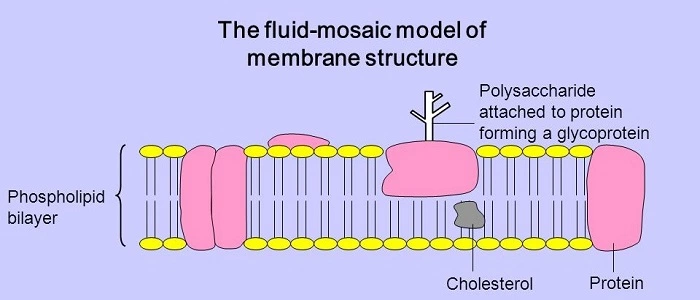
How did Fluid mosaic model come into existence?
S.J. Singer along with G. L. Nicolson came up with Fluid mosaic model in order to provide an explanation on the structure of plasma membrane. It was considered as a basic structure of cell membrane which would help in explaining the present data on the proteins and lipids present in the membrane helping in future experiments (Nicolson, 2016). Although the model has evolved with time but still it is considered as a relevant theory when it comes to describing the nano-structures of different intra and cellular membranes present in the cells of plants and animals. The Fluid mosaic model is an arrangement of the particles in the cell membrane. In the meanwhile certain new information’s came into light like lipid rafts, proteins and glycoproteins which helped in describing the structure of the membrane. The new information’s related to the cell membrane came into light due to the concepts mentioned to define Fluid mosaic model. The latest information’s pay more importance to the mosaic character (Nicolson, 2016).
What are the different organelles of a cell?
Cell Organelles refers to different cellular components found in plants and animals. Cell consists of different structures known as organelles. The cell organelles have a membrane which is present in the cell having a distinct structure and function (Morange, 2013). The cell membrane holds all the components of a cell and protects it from the outside environment. It also helps ion regulating particles entering and exiting the cell. These cell organelles work in coordination for normal functioning of the cell. Some of the cell organelles have been discussed below:
- Endoplasmic Reticulum:
It is an arrangement of membrane canals which is filled with fluids. They are regarded as a transportation system helping in transporting materials inside the cell. Endoplasmic Reticulum forms a part of endomembrane system giving an extension to nuclear envelope. Endoplasmic Reticulum is made up of two types, Rough Endoplasmic Reticulum and Smooth Endoplasmic Reticulum. The Rough Endoplasmic Reticulum is composed of tubules, vesicles and cisternae. They are found all over the cell and help in the making of proteins. Smooth Endoplasmic Reticulum functions as a storage house. It helps in the production of steroids and lipids. It also helps in detoxing the cell. The Rough Endoplasmic Reticulum consists of many ribosomes attached with it which gives an uneven structure and thereby justifying its name. Rough Endoplasmic Reticulum helps in synthesizing proteins which are transferred from the cell. These proteins are transferred to the lumen which is placed inside the Endoplasmic Reticulum where it is modified into a complex shape. The lumen transfers the protein to the Smooth Endoplasmic Reticulum where it is further processed. The Smooth Endoplasmic Reticulum has no ribosomes which help in providing a smooth structure. It cannot make proteins due to lack of ribosomes. The main function of Smooth Endoplasmic Reticulum is making lipids, and enzymes.
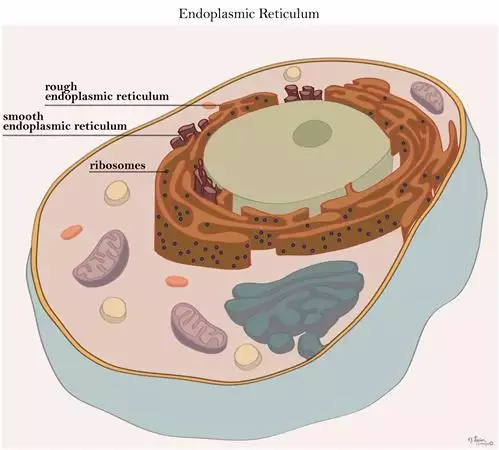
Source: (Dvorzhinskiy, 2018)
Functions of the Endoplasmic Reticulum:
- Helps in the production and secretion of steroid hormones
- Helps in the synthesis of lipids like phospholipid and cholesterol
- Helps in metabolism of carbohydrates
- Helps in releasing calcium ions which is important for the nervous and muscular system
- Ribosomes: It is a place where the the protein synthesis takes place making protein and ensuring survival of the living cells. It consists of different molecules. Ribosomes are found in all types of cells like prokaryotic and eukaryotic cells. Each and every cell requires ribosomes for manufacturing of proteins. The ribosomes are made up of small and large subunit consisting of ribosomal RNA and Ribosomal proteins. During protein synthesis the messenger RNA(mRNA) is moving throughout the ribosome and the amino acids which is attached to the transfer RNA( tRNAs) is brought towards to the ribosome. Amino acids help in the production of proteins. The ribosomes are attached to the Rough Endoplasmic Reticulum. They are free and float in the cytoplasm. They are very small in nature with no membranes. It is composed of two third of ribonucleic acid and one third protein. They are also known as 70’s which is found in prokaryotes or 80’s which is found in eukaryotes. S refers to density and size. Ribosomes can be found in the face, skin, hair and eyes.
Functions of Ribosomes:
- Helps in assembling amino acids for the formation of the proteins which is considered as an essential part for the functioning of the cell
- Messenger RNA(mRNA) helps in synthesizing proteins with the help of nucleus and cytoplasm
- Ribosome sub-units inside the cytoplasm surround the Messenger RNA(mRNA) polymers.
- The synthesized ribosomes transports the proteins outside the cell
- Golgi apparatus: Golgi complex or the Golgi apparatus which is present in the cytoplasm of both plant and animal cells. It is a flat and layered sac like organelle which modifies the proteins and helps in its packaging. It is a set of membranes working closely with endoplasmic reticulum modifying the proteins and the carbohydrates. It generally consists of 3 to 20 cisternae but usually has 6 cisternae’s. The Golgi apparatus is found in eukaryotic cells. It is enclosed through membrane which varies in its size from regions to regions. It is actively involved in manufacturing, storage and transportation of products from the Endoplasmic Reticulum. The membranes in the Golgi apparatus are folded leading to a structure like a pancake. It is a home to many vesicles which is produced by the Smooth Endoplasmic Reticulum. The Golgi apparatus helps in processing the proteins made by Endoplasmic Reticulum before circulating it in the cell. Endoplasmic Reticulum helps the protein to enter from one side into the Golgi apparatus and exit from the opposite side towards to plasma membrane of the cell. Fluid mosaic model is one of the accepted models of plasma membrane. Golgi bodies present in a cell may vary depending upon its functions.
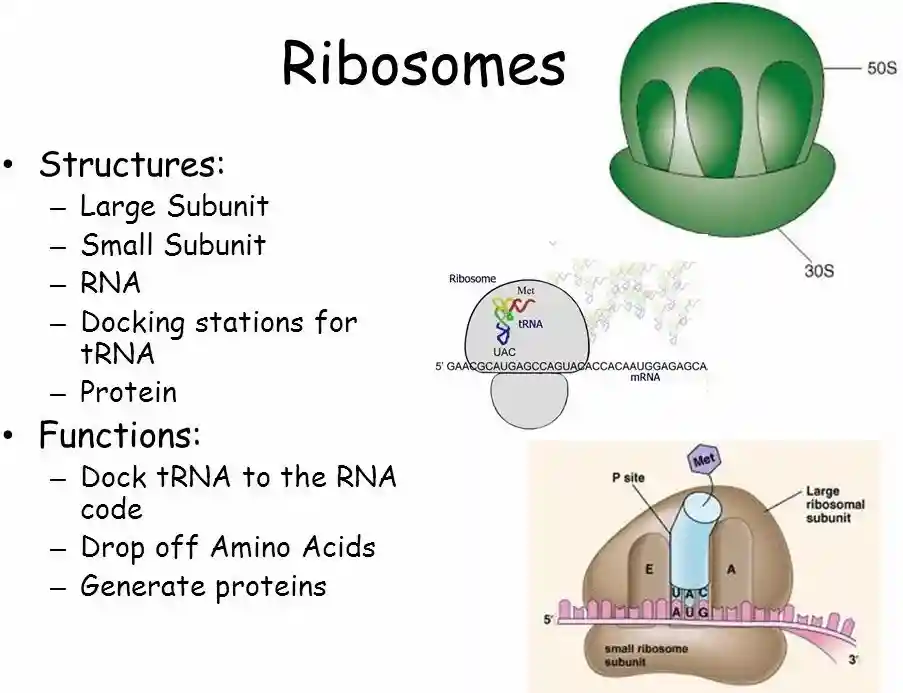
Source: ( Walker, n.d)
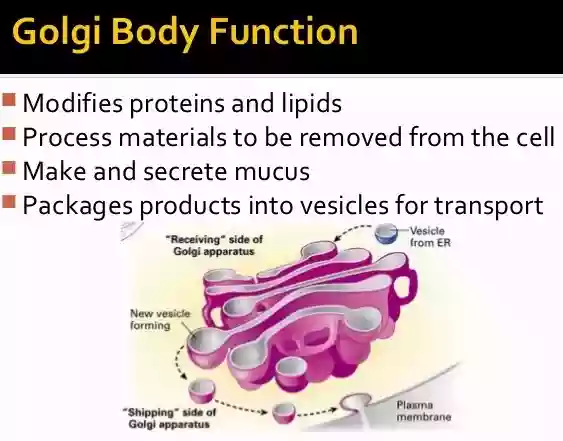
Source: ( Mandira and Kate, 2017)
Functions of Golgi complex:
- Absorbing the compounds
- Helps in secretion and forming secretory vesicles
- Helps in the formation of enzymes
- Helps in producing hormones
- Helps in storing proteins
- Helps in the formation of acrosome
- Helps in the formation of intracellular crystals
- Helps in the forming droplets of milk protein
- Helps in the forming the wall of the plant cell
- Helps in the secretion of glycoproteins
- Lysosomes: Lysosomes are commonly referred to sacs of enzymes. It helps in digesting different lipids and nuclei acids present in a cell. The conditions present inside the lysosomes show an acidic nature. The conditions present in the lysosomes membrane provides a favorable condition for the functioning of the enzymes. They can be found in the cytoplasm. Lysosome helps in breaking down the cells which are dying, organelles, toxins and particles of food. Lysosomes are often known as suicidal bags. The membrane sacs of the lysosome buds from the Golgi complex. Lysosomes have different roles and one of them is lysosomes serving like a vessel for disposal of waste ( Pu, Guardia, Keren-Kaplan and Bonifacino, 2016). The molecules responsible for processing Lysosomes may lead to controlling different diseases as well as ay be a cause of different diseases.
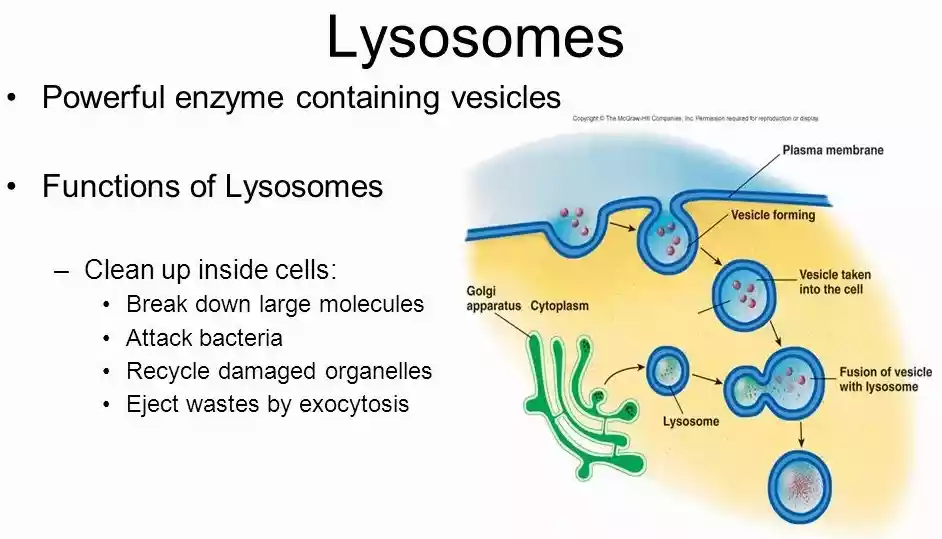
Source: (Fields, n.d)
Functions of lysosomes:
- Helps in intracellular digestion
- Helps in removing dead cells
- Helps in the process of metamorphosis
- Helps in the process of protein synthesis
- Helps in the process of fertilization
- Has a role in the process of ontogenesis
- Helps in removing toxins
- Helps in digesting food particles
- Helps in forming bone cells
What is Kartagener syndrome and how is it caused?
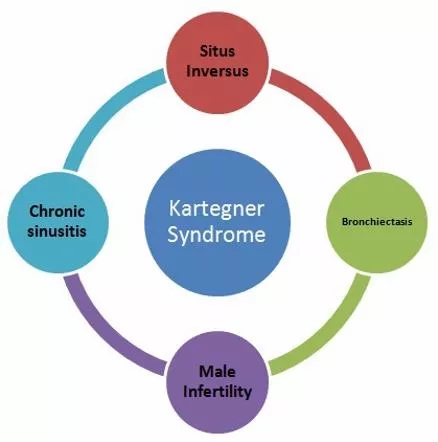
Source: (Plessis and Wahba, (n.d))
Kartagener syndrome is referred to a situation wherein a person suffers with acute sinusitis, bronchiectasis and situs inverse. When there is an abnormal acquisition of motor protein dynein then it leads to Kartagener syndrome. When the cicilia moves in a defective manner, it leads to chest infections and infertility (Xu, Gong and Wen, 2017). The mucus is filled by biofilms collected from the air which results into bacterial infections and the inflammation damages the tissue. Men’s affected with Kartagener syndrome may produce infertile sperms and these men can become fathers only with the help of a doctor who can inject the sperm cells into the eggs. Kartagener syndrome is caused when there is a defect in the genetics. It occurs when both the parents are affected with the disease and the syndrome is carried into their child.
What is the role of abnormal dynein in causing the syndrome? How it alters the flagella? How it leads to building of mucus in the airway?
Kartagener syndrome is caused due to genetic disorder. It is caused due to the formation of protein dynein’s. People who get affected by the disease suffer from chronic sinus and building of mucus in the airways leading to the lungs. There is a possibility of bacterial formation in the mucus. If the disease is hereditary then it may lead to severe bronchiectasis in the childhood or adulthood and can cause respiratory failure. The disease is also affected by cilia and flagella which are attached to the outer body of the eukaryotic cells. The cilia are responsible for the movement of the mucus and it helps to remove unwanted elements from the airways. When the cilia are unable to function properly it may lead to malfunctioning in the breathing system and may raise difficulty while breathing.
How does Kartagener syndrome cause infertility?
Males who are diagnosed with Kartagener syndrome may produce infertile sperms. The production of sperm is normal but they are affected due to dynein flagella being absent or the flagella have become short. But in such cases consulting a doctor is the best option who can help the males to become fathers by injecting the eggs with their sperm cells.
The present paper has discussed about the Fluid mosaic model, how it came into existence and why it is so named. The paper also discusses about different cell organelles along with a reference to Kartagener syndrome.
Reference List
Catala, A. (2012) Lipid peroxidation modifies the picture of membranes from the “Fluid Mosaic Model” to the “Lipid Whisker Model”. Biochimie, 94(1), pp. 101-109.
Dvorzhinskiy, A. (2018) Endoplasmic Reticulum. Retrieved from: https://step1.medbullets.com/biochemistry/102073/endoplasmic-reticulum
Fields, P. (n.d) Chapter 3 Cell Anatomy Cell = Chamber/Compartment. Retrieved from: https://slideplayer.com/slide/7250637/
Leabu, M. (2013) The still valid fluid mosaic model for molecular organization of biomembranes: accumulating data conform it. Discoveries, 1(1), e7.
Mandira, P and Kate, M. (2017) What is the function of the Golgi complex? Retrieved from: https://socratic.org/questions/what-is-the-function-of-the-golgi-complex
Morange, M. (2013) What history tells us XXX. The emergence of the fluid mosaic model of membranes. Journal of Biosciences, 38, pp. 3-7.
Nicolson, G.L. (2016) The Fluid Mosaic Model of Membrane Structure: Still relevant to understanding the structure, function and dynamics of biological membranes after more than 40 years. Biochimica et Biophysica Acta (BBA)- Biomembranes, 1838(6), pp. 1451-1466.
Plessis, V.D and Wahba, M. (n.d) Kartagener syndrome. Retrieved from: https://radiopaedia.org/articles/kartagener-syndrome-1
Pu, J., Guardia, C.M., Keren-Kaplan,T and Bonifacino, J.S. (2016) Mechanisms and functions of lysosome positioning. Journal of Cell Science, 129, pp. 4329-4339.
Walker, E. (n.d) Cellular Organelles: How is structure related to function? Retrieved from: https://slideplayer.com/slide/8532041/
Xu, X., Gong, P and Wen, J. (2017) Clinical and genetic analysis of a family with Kartagener syndrome caused by novel DNAH5 mutations. J Assist Reprod Genet, 34(2), pp. 275-281.












